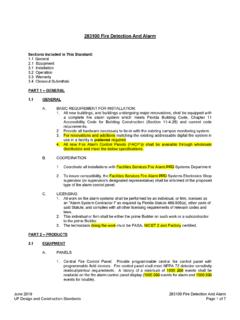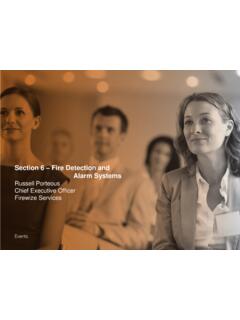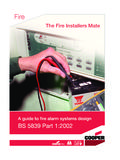Transcription of Fire Detection Systems Guide - gcg-es.com
1 Conventionalsystemoperationdetection line operationConventional Detection systemsnormally operate on a 24 VDC the standby condition, thedetectors will draw a low current,typically less than 100 A. When thedetector senses a fire , it will switchinto the alarm condition with it'sLED illuminated, and will collapsethe line voltage by drawing a largercurrent - dependant on thedetectors and control panel, buttypically 50-80mA. The controlpanel can sense this, and activatethe appropriate alarms. Thedetector will remain latched in thealarm state with its LEDsilluminated, even if the smokeorheat is removed until it has beenresetfrom the panel by momentarilyremoving powerfrom the allows the fire to be locatedeven if the signal is intermittent,orto locate possible sourcesofnuisance some control panel - detectorcombinations, when a standardbase is used, there is anincompatibility between the currentspecifications of the detector andpanel, leading to incorrect reportingby the control panel, for examplesignalling a fault in place ofanalarm, and in some cases damageto the detector due to over currentin the alarm state.
2 In these casesitis necessary to use a base fittedwith a resistor in series with thedetector to limit the current drawin alarm. Resistors fitted into thedetector baseare also used insome cases to distinguish betweena short circuit fault and an value of the base resistorisdependant on the control panel,however a typical value is 470 Ohms. If in any doubt, contact thecontrol panel manufacturer whoshould be able to specify whichdetector bases should be usedwith different detector manual call-point consists of asimple switch with a resistorinseries with it, usually 470 Ohmsor680 Ohms. When the call pointisactivated, the resistor is switchedacross the line, and a current of50-80mA, dependant on thecontrol panel, is linefault monitoringStandard conventional systemsareable to monitor the zone for shortcircuit, open circuit and detectorhead a short circuit occurs on azone, a high current will be drawn,and the line voltage will be pulledtowards zero volts.
3 The paneldetects the low voltage/highcurrent and a fault is to detect an open circuit,ordetector head removal, a deviceisconnected across the end of thezone, which can be device can take various formsdependant on the control +24 VContact Closedwhen detectorinserted in baserotsiseRFigure 2: Resistive end of line operationThe simplest end of line device isa resistor, which will draw a currentdistinctfrom the quiescent andalarm currents drawn by thedetectors. Installation of detectorsinto their bases closes a contactinthe base supplying the remainderofthe zone. Thus if the line isbroken,or if a detector head is removed,the current drawn by the zone willfall, and a fault will be signalled(See figure 2). Example zone currentand voltage figuresare given in figure with a simple resistiveend of line is that should a detectorhead be removed, the remainderofthe zone beyond that detectorislost and no alarm can be signalledbeyond this point.
4 Should a callpoint be mounted beyond theremoved detector, it will no longerwork, which contravenes therequirements of BS5839 part1. Toovercome this either all call pointsmust be mounted at the startofeach zone, or in completelyseparate zones (both of thesesolutionsare often impractical andtoo costly), or head removalmonitoring can be monitoring uses bases fittedwith a diode across the contactinthe base (fig 4). Whilst the detectoris mounted in the base, the basecontact connects directly across thediode, and links it out. There isusuallyprovision for manuallylinking the diode out to permitcontinuity testing duringcommissioning. When the detectorhead is removed, the diodeisconnected across the contact,allowing power to continue tobesupplied to the remainder of thezone, whilst still permitting theremoved detector to be is achieved in a numberof active end of line device uses aswitched resistor at the end of lineand can thus be used with astandard control panel.
5 It sends aperiodic signal back along thedetection line, which is normallyquenched by the control a head is removed, the basediode is switched into the line, andpulse can be seen. The Active endof line then switches the resistor outof the line, and a fault is a capacitive end of line is used,the panel periodicallydrops the linevoltage for a few milliseconds, andlooks for the line voltage being heldup by the capacitor. When a headisremoved, the panel will see the linevoltagedrop immediately as thecapacitor's discharge willbeinhibited by the diode, and therebya fault can be third type of end of line deviceisa diode. With this the panelperiodically reverses the line voltagefor a few milliseconds: If the lineisbroken by the diode in the detectorbase, then no current can flowinthe reverse type of end of line monitoringused on a system will dependon the control panel.
6 However itis important, particularly whenusing active end of line monitoring60V+ Closeswhen detectorinserted in baseFigure 3: Example resistive conventional system current and voltage figuresFigure 4: Active end of line monitoring circuitMonitoring of Detection line(example only)egatloVtnerruCnoitidnoCV42Am3<tiucr iCnepONormal5mA (dependant on EOL device)Fire50mA (dependant on control panel)Short CircuitHigh (dependant on control panel)18V4-15V0 Vto ensure that the detectorsare compatible with the typeof monitoring being must be made tothe panel manufacturer toensure LEDsMost system smoke detectorsareequipped with a terminal to allowthe connection of a remote LEDsare often usedoutside bedroom doors in hotelssothat in case of a fire , it is easy forthe fire brigade to identify thelocation of the fire without needingto enter every room in the may also be used where adetector is located in a hiddenposition, such as a floor or roof voidor cable tunnel, for example,toprovide a visual indication that thedetector is in an alarm system operationIn some cases it is necessary thatthe power to the detectors and thefi re Detection signal be on separatewires, see figure 5.
7 In this instance,a base incorporating a change overrelay is used. This configurationisknown as a four-wiresystem, andisoften seen when a fire zoneisintegrated into a security 5 shows the simplest formoffour-wire system , as used with mostsecurity panels. This is used wherethe monitor line is able onlytoregister an open or closed circuit -there is no distinction between afault and a fire . By using a normallyclosed relay at the end of the powerline, it is possible to monitor for apower failure to the detectors. Therelay contactsare wired in serieswith the normally closed contactsofthe detector relay base(s). Thusinthe normal state the detectioncircuit is closed; in the case of fireor power failure the relevant relaycontacts will after an alarm, thedetectorsare reset by disconnectingthe power to the relevant zone for ashort period bypressing a centralpanel reset button.
8 fire panels havethis facility built in, however manysecurity panelsare unable to do thiswithout turning the entire to allow the useofdetectors with security panels,non-latching versions of the relaybasesare usually made available,which automatically isolate thedetectorfrom the supply every fewseconds. Thus once the firecondition has passed the detectorwill automatically reset (note thatthe alarm condition shouldbelatched at the control panel.)Four-wire type systemsare alsooften used with devices suchasbeam detectors where an auxiliary7 CNO NCCNO NCEnd of LineMonitoring RelayFIREALARMCONTROLPANELD etection Line(Open Circuit forAlarm and Fault)Power Supply(Nominal 12 Vor 24V system )MRALA)O/N(YALERTLUAF)C/N(YALERECN ANETNIAM)C/N(YALERNICDV42+TUOCDV42-TUOCD V42+NICDV42-MRALA)O/N(YALERTLUAF)C/N(YAL ERECNANETNIAM)C/N(YALERNICDV42+TUOCDV42- TUOCDV42+NICDV42-LOE2#ROTCETEDMAEB1#ROTC ETEDMAEB+ 24 VDCDETECTION CIRCUIT- 24 VDCPOWER SUPPLYEND OF LINERELAY COIL rotsiseRrotsiseRFigure 5: Typical 4 wire system wiringFigure 6: 4-wire system with full 2/12/08 10:46 Page 39










